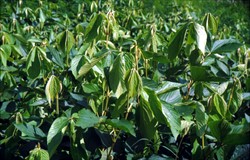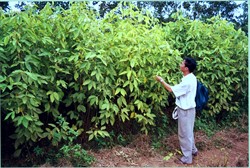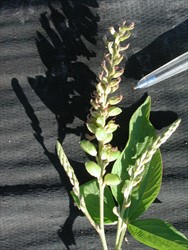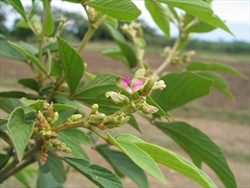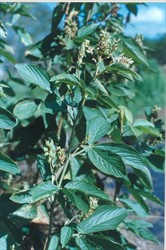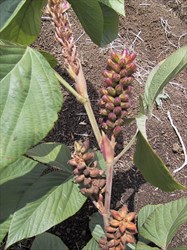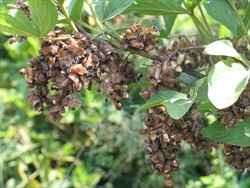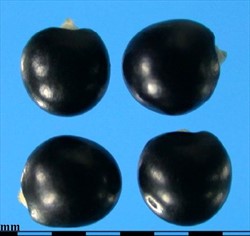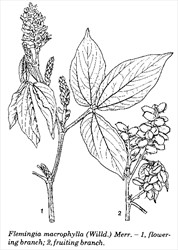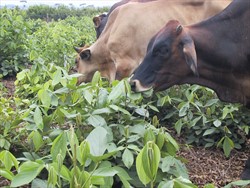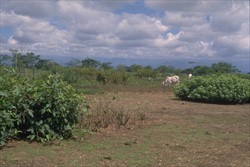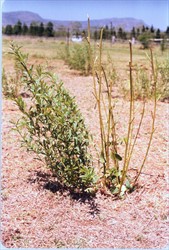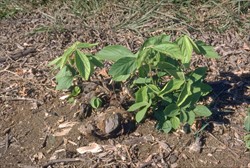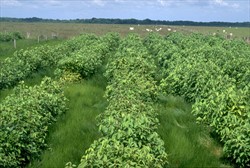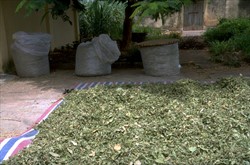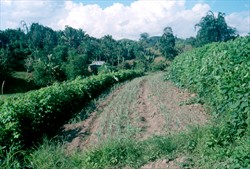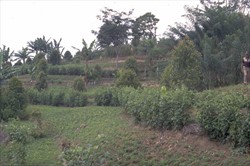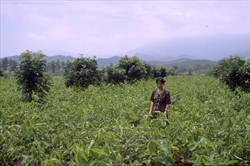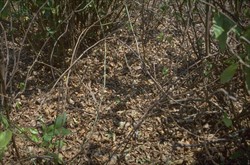Tropical Forages
Basionym: Crotalaria macrophylla Willd.; Flemingia congesta Roxb. ex W.T. Aiton; Moghania macrophylla (Willd.) Kuntze
Family: Fabaceae (alt. Leguminosae) subfamily: Faboideae tribe: Phaseoleae subtribe: Cajaninae.
Perennial, deep-rooting, leafy shrub, 0.5‒2.5 (‒3) m high. Prostrate to erect growth habit, numerous stems arising from the base. Leaves trifoliolate, leaflets elliptic-lanceolate, 5‒15 cm long, 2‒8 cm wide, silky or hairless, papery when old. Inflorescences mostly dense, axillary racemes, 5‒30 cm long, with 15‒40 flowers; calyx 7‒13 mm long; corolla 14 mm long, white to pink or yellowish, densely silky, standard greenish with distinct red blotches or stripes and purple apex, wings rose-pink. Pods oblong, 11‒15 mm long, 5‒7 mm wide, dark brown and slightly silky, dehiscent, 2‒seeded. Seeds globular, mottled brown or shiny black, 2‒3 mm in diameter. 45,000‒97,000 seeds per kg.
English: large leaf flemingia, warrus (waras) tree
Asia: barasalpan, charchara, dalia (Bangladesh); 大叶千斤拔 da ye qian jin ba (China); basa-salpan, bhalia, bisbut, samnaskahat (India); apa apa, hahapaan, pok kepokan (Indonesia); enoki-mame (Japan); thwàx h'èè h'üad, hom sam muang, ko dok kam, thoua huat (Laos); serengan jantan, beringan (Malaysia); batwasi, kamatteri (Nepal); wal-undu (Pakistan); laclay-guinan, gewawini, malabalatong (Philippines); mahae-nok, khamin naang, khamin ling (Thailand); tóp mo'láto, cây dau ma, cai duoi chon (Vietnam)
Native:
Asia: Bhutan, Cambodia, China (s.?), India, Indonesia, Laos, Malaysia, Myanmar, Nepal, Pakistan (n.), Sri Lanka, Taiwan, Thailand, Vietnam
Cultivated/naturalized:
Africa: sub-Saharan
Asia: widely through humid tropics.
Anericas: humid tropical areas
Forage
It is considered a poor forage since it has high fibre and condensed tannin concentrations and is not readily eaten by stock. More suitable for small ruminants than for cattle.
Environment
Most commonly used in contour hedgerows for erosion control, often in association with Desmodium cinereum (formerly known as D. rensonii). Prunings are used for mulch (slow breakdown of leaf due to high concentration of condensed tannins) and green manure in alley cropping systems. It is also used to shade young coffee and cocoa plants, for weed suppression and soil enrichment in orchards, and to provide fuel wood and stakes for climbing crop species.
Other
Pods provide a brilliant orange dye for silk. F. macrophylla is a host plant for Lac insects (Kerria lacca Hemiptera: Kerriidae) cultivation in India.
Soil requirements
Will grow on most soils, with very low to moderate (and even high) fertility, with a pH range from 4 to 8, and high soluble aluminium (up to 80% saturation).
Moisture
Requires a minimum annual rainfall of about 1,100 mm, and grows up to 3,500 mm. tolerating up to 6 months dry season. Capable of surviving on poorly drained and occasionally waterlogged soils.
Temperature
Best growth between 22 and 28 ºC, producing minimal growth above 36 °C and below 12 °C. Found from sea level to 2,000 m asl.
Light
Moderately shade tolerant.
Reproductive development
Short day flowering response.
Defoliation
Plants grow vigorously once established, if adapted. Excellent coppicing and regrowth capacity after cutting, producing numerous shoots from buds near the base of the stem. Cut at intervals of 6‒14 weeks at 35‒100 cm above the ground. Cutting interval depends on climatic conditions.
Fire
Well established plants tolerate fire.
Guidelines for establishment and management of sown forages.
Establishment
To improve germination, seeds should be soaked in boiled water for 2‒3 minutes, stirring the whole time, followed by soaking in cool water for 12 hours. Reasonable results being obtained from cool water soaking alone. Seedlings emerge in 7‒14 days. Scarification with concentrated sulphuric acid for 15 minutes is more effective than the hot water treatment, but is more hazardous to the operator. Planting density varies according to the use. For large areas, it can be planted in rows 90 cm apart with a seed planted every 10‒20 cm. For hedgerows, it is important to have minimal space between plants within the row if erosion control is to be effective. Weed control is necessary for 3‒6 months after emergence, since early growth is slow and young plants are sensitive to competition. Although somewhat promiscuous, best to inoculate seed with strains of Bradyrhizobium such as CB 756, CIAT 4203, or CIAT 4215.
Fertilizer
Although adapted to infertile soils, limited fertilizer is beneficial. In Brazil, about 75 kg/ha/yr of biologically fixed nitrogen have been measured.
Compatibility (with other species)
Seedlings are slow to develop and cannot compete with other species. Once established, plants are strongly perennial and can tolerate competition from companion species. Beneficial effect on trees is reported when Flemingia is used as mulch-providing plant such as in orchards. Can act as a trellis for twining legumes.
Companion species
Grasses: Any grass once F. macrophylla becomes established.
Legumes: Twining, trellis-seeking species such as Centrosema spp.
Pests and diseases
Not susceptible to any major diseases. Can be used to reduce nematode populations of Pratylenchus spp., Helicotylenchus spp. and Rotylenchus spp., but not of Meloidogyne spp. Flemingia is an off-season host for the pigeonpea pod fly, Melanagromyza obtusa, which can reduce seed yields.
Ability to spread
Spreads by seed only.
Weed potential
Considered to be low.
Nutritive value
Lower leaf nutrient levels (especially K, Ca, and Mg) than Leucaena leucocephala and Gliricidia sepium (11.3‒24.4% CP; 0.15‒0.3% P; 1.0‒1.4% K; 0.13‒0.94% Ca; 0.2‒0.3% Mg). IVDMD values for foliage range from 11 to 60%, most values tending to be in the lower part of the range; in sheep, an apparent DM digestibility of 54% has been reported. Low IVDMD values result from high tannin and lignin levels in the leaves; depending on accession, concentrations of 0‒27% extractable condensed tannins and 17‒39% lignin have been reported.
Palatability/acceptability
Palatability is adversely affected by high tannin content of the leaves, immature leaves being considerably more palatable than mature herbage. Can be 'disguised' by mixing with grasses and other legumes. Under grazing and in mixture with other species, low palatability can lead to dominance of F. macrophylla. Palatability is very low in the wet season but reasonable in the dry season.
Toxicity
Detection of saponin has been reported.
Feedipedia link
April 2020: Page under construction
Dry matter
Yields depends on growing conditions, and range from 3 to 12 t leaf DM/ha/yr, more commonly <8 t/ha.
Animal production
Has been fed to lactating dairy goats for 120 days without harmful effects, although another report showed growth and milk production of goats decreased when Flemingia foliage supplied more than 15% of the dietary DM. Other studies report upper limits in the range of 7.5‒75% F. macrophylla in the diet of lactating goats.
2n = 22. There is a large germplasm collection available with considerable variation regarding important features.
Produces flowers and seed within 6‒7 months from planting, although first year seed yields are low. Pods are dehiscent, so need to be harvested regularly (twice per week handpicking of ripe pods) before the discharge of seeds. Cumulative yields of up to 200 kg/ha seed can be obtained. Pigeonpea pod fly (Melanagromyza obtusa) can reduce seed yields if active.
No information available.
- Strongly perennial, multipurpose shrub.
- Adapted to acid, infertile soils with high Al.
- Some tolerance of waterlogging.
- Suited to low-input smallholder production systems.
- Drought and shade tolerant.
- Vigorous, leafy growth after cutting.
- Slow breakdown/nutrient release of leaf when used as mulch.
- Dry season forage for (mainly small) ruminants.
- Very poor quality forage for ruminants.
- Low digestibility because of high tannin and fibre content.
- Low palatability to cattle, particularly in the wet season.
- Slow establishment.
Andersson, M.S., Lascano, C.E., Schultze-Kraft, R. and Peters, M. (2006) Forage quality and tannin concentration and composition of a collection of the tropical shrub legume Flemingia macrophylla. Journal of the Science of Food and Agriculture 86:1023–1031. doi.org/10.1002/jsfa.2433
Andersson, M.S., Schultze-Kraft, R., Peters, M., Hincapié, B. and Lascano, C.E. (2006) Morphological, agronomic and forage quality diversity of the Flemingia macrophylla world collection. Field Crops Research 96:387–406. doi.org/10.1016/j.fcr.2005.09.002
Asare, E.O., Shehu, Y. and Agishi, E.A. (1984) Preliminary studies on indigenous species for dry season grazing in the northern Guinea savanna zone of Nigeria. Tropical Grasslands 18:148–152. bit.ly/2QT0Rnk
Aviz, M.A.B. de, Lourenço Jr., J.B., Camarão, A.P., Garcia, A.R., Araújo, C.V., Monteiro, E.M.M. and Santos, N.F.A. dos (2009) Valor nutritivo da leguminosa Flemingia macrophylla (Willd.) Merrill para suplementação alimentar de ruminantes na Amazônia Oriental. Amazônia: Ciência & Desenvolvimento 4:253–272. bit.ly/39pBvUz
Budelman, A. and Siregar, M.E. (1992) Flemingia macrophylla (Willd.) Merr. In: Mannetje, L't. and Jones, R.M. (eds) Plant Resources of South-East Asia No. 4. Forages. Pudoc Scientific Publishers, Wageningen, the Netherlands. p. 131–133. edepot.wur.nl/327785
Mui, N.T., Ledin, I., Udén, P. and Binh, D.V. (2002) The foliage of Flemingia (Flemingia macrophylla) or Jackfruit (Artocarpus heterophyllus) as a substitute for a rice bran - soya bean concentrate in the diet of lactating goats. Asian-Australasian Journal of Animal Sciences 15:45–54. doi.org/10.5713/ajas.2002.45
Oiticica, I.N., Fonseca, C.E.M. da, Souza, V.C. de, Silva, A.B. da, Lopes, F.C.F. and Morenz, M.J.F. (2015). Flemingia macrophylla in goat feeding. Revista Brasileira de Zootecnia 44:335–341. doi.org/10.1590/S1806-92902015000900005
Salmi A.P., Risso, I.A.M., Guerra, J.G.M., Urquiaga, S., Araújo, A.P. de, Abboud, A.C.S. 2013. Crescimento, acúmulo de nutrientes e fixação biológica de nitrogênio de Flemingia macrophylla. Revista Ceres 60:79–85. doi.org/10.1590/S0034-737X2013000100012
Skerman, P.J., (1977) Tropical forage legumes. FAO Plant Production and Protection Series No. 2. Food and Agriculture Organization of the United Nations (FAO), Rome, Italy. p. 243–255. doc1.bibliothek.li/aay/FLMA174882.pdf
